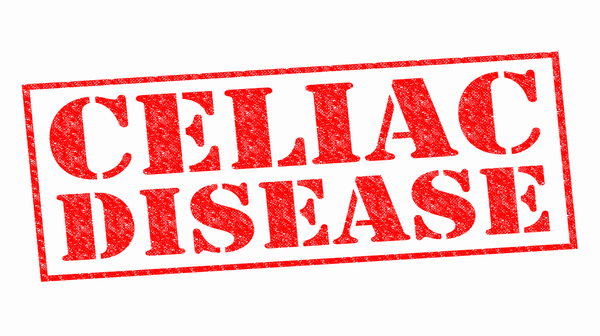What's in this article?
What is Celiac Disease?
Celiac disease is an autoimmune disorder that can occur in genetically predisposed people where the ingestion of gluten leads to damage in the small intestine. It is estimated to affect 1 in 100 people worldwide. Two and one-half million Americans are undiagnosed and are at risk for long-term health complications.
When people with celiac disease eat gluten (a protein found in wheat, rye and barley), their body mounts an immune response that attacks the small intestine. These attacks lead to damage on the villi, small fingerlike projections that line the small intestine, that promote nutrient absorption. When the villi get damaged, nutrients cannot be absorbed properly into the body.
Celiac disease is hereditary, meaning that it runs in families. People with a first-degree relative with celiac disease (parent, child, sibling) have a 1 in 10 risk of developing celiac disease.
What Causes Celiac Disease?
Normally, the body’s immune system is designed to protect it from foreign invaders. When people with celiac disease eat foods containing gluten, their immune system forms antibodies to gluten which then attack the intestinal lining. This causes inflammation in the intestines and damages the villi, the hair-like structures on the lining of the small intestine. Nutrients from food are normally absorbed by the villi. If the villi are damaged, the person cannot absorb nutrients properly and ends up malnourished, no matter how much he or she eats.
How common is Celiac Disease and who is affected?
As many as one in 141 Americans has celiac disease, although most remain undiagnosed.2 Celiac disease affects children and adults in all parts of the world and is more common in Caucasians and females.
Celiac disease is also more common among people with certain genetic diseases, including Down syndrome and Turner syndrome––a condition that affects girls’ development.
Symptoms of Celiac Disease
The signs and symptoms of celiac disease can vary greatly.
Although the classic signs are diarrhea and weight loss, most people with celiac disease experience few or no digestive signs or symptoms. Only about one-third of people diagnosed with celiac disease experience diarrhea, and about half have weight loss.
Twenty percent of people with celiac disease have constipation, and 10 percent are obese.
In addition to digestive problems, other signs and symptoms of celiac disease include:
- Anemia, usually resulting from iron deficiency
- Loss of bone density (osteoporosis) or softening of bone (osteomalacia)
- Itchy, blistery skin rash (dermatitis herpetiformis)
- Damage to dental enamel
- Headaches and fatigue
- Nervous system injury, including numbness and tingling in the feet and hands, and possible problems with balance
- Joint pain
- Reduced functioning of the spleen (hyposplenism)
- Acid reflux and heartburn
Children
As many as 75 percent of children with celiac disease are overweight or obese. Digestive signs and symptoms are experienced by 20 to 30 percent of children with the condition although the precise signs and symptoms differ by age.
In infants, typical signs and symptoms of celiac disease include:
- Chronic diarrhea
- Swollen belly
- Pain
- Failure to thrive or weight loss
Older children may experience:
- Diarrhea
- Constipation
- Short stature
- Delayed puberty
- Neurologic symptoms, including attention-deficit/hyperactivity disorder (ADHD), learning disability, headaches and lack of muscle coordination
Diagnosis of Celiac Disease
Screening
Until recently physicians had to rely on clinical signs to suggest the diagnosis and to select which patients should have further investigation to prove the diagnosis. Since these signs may be vague or of varying severity this may be difficult. Now simple blood screening tests are becoming available to help this process.
Biopsy
A definitive diagnosis can only be made by a small bowel biopsy. The biopsy is performed by a specialist in the gastrointestinal field. The biopsy must be done before treatment is started. Recommendations by International Celiac Societies and Associations regarding diagnosis of celiac disease as researched by Dr. Mohsin Rashid, Professional Advisory Board of CCA.
Treatment for Celiac Disease
Once celiac disease is diagnosed, a doctor will help treat it. Although there is no cure, celiac disease can be managed successfully by following a gluten-free diet. People with celiac disease need to follow this diet for life. Because gluten can be found in everything from breakfast cereals to prepared luncheon meats, they need to be very aware of what’s in the foods they eat.
If you’ve been diagnosed with celiac disease, a doctor or dietitian who specializes in celiac disease can help you develop an eating plan that works with your lifestyle.
Luckily, the small intestine can heal. Although this can take up to a year, many people start to feel better after just a few days on a gluten-free diet. But feeling better doesn’t mean that people with celiac disease can eat foods containing gluten again. The genes that cause the disease are in the body and the immune system continues to react to gluten, so the symptoms and problems will return if someone with celiac disease starts eating gluten again.
Living With a Gluten-Free Diet
A gluten-free diet will be a big change in your life. You have to rethink your eating habits, including what you buy for lunch, what you eat at parties, or what you snack on. Following a gluten-free diet means you cannot eat many dietary “staples,” including pasta, cereals, and many processed foods that contain grains. You will need to be careful when eating packaged foods, as they may contain gluten. Always read the ingredients of packaged foods and when eating in restaurants, ask about the ingredients of a dish before ordering.





